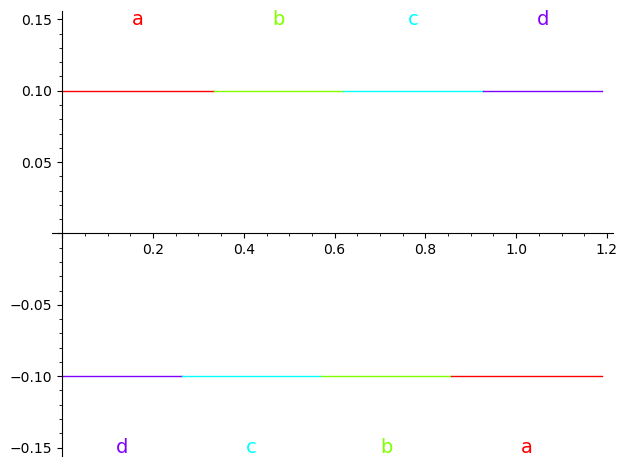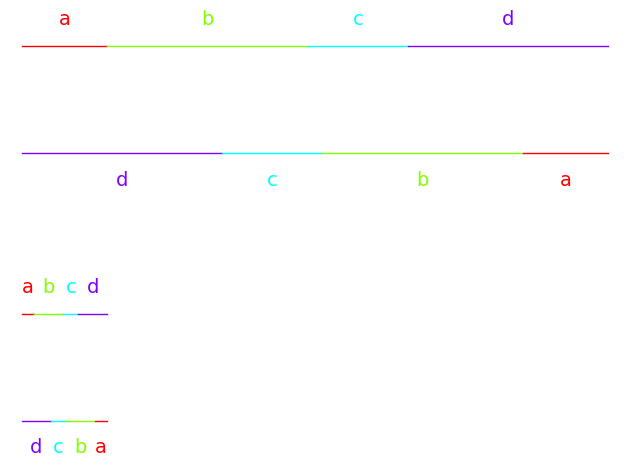Interval Exchange Transformations#
Introduction#
This file is a good entry point to learn how to use interval exchange transformations in surface-dynamics. Recall that an interval exchange transformation is a piecewise translation of an interval. It can be encoded by a pair \((\pi, \lambda)\) where \(\pi\) is a permutation and \(\lambda\) is a vector of positive real numbers. These are respectively called the combinatorial datum and the length datum of the interval exchange transformation.
Building an interval exchange transformation and simple manipulations#
Here is an example of interval exchange transformation on 4 subintervals with rational lengths
from surface_dynamics import iet
perm = iet.Permutation('a b c d', 'd c b a')
length = [1/3, 2/7, 4/13, 5/19]
t = iet.IntervalExchangeTransformation(perm, length)
print(t)
Interval exchange transformation of [0, 6172/5187[ with permutation
a b c d
d c b a
It can be visualized with:
G = t.plot_function()
G.set_aspect_ratio(1)
G # random (matplotlib warning in conda)
t.plot_two_intervals()

Given a point in the interval \([0, 6172/5187[\) it is possible to compute its image under the map \(t\)
x = 1/12
t(x)
19501/20748
To know which translation has been applied to the point \(x\) you can use
print(t.in_which_interval(x))
print(t.translations())
print(x + t.translations()[0] == t(x))
a
(1481/1729, 176/741, -142/399, -253/273)
True
Can you compute the first 20 elements of the orbit of \(x\), that is the sequence \((x, t(x), t^2(x), \ldots, t^{19}(x))\)?
Can you determine whether the orbit of :math:x is periodic, that is whether
there exists \(n > 0\) such that \(t^n(x) = x\)?
To construct an interval exchange on other numbers than rationals you need to manipulate exact real numbers. The current sage version (9.2) only supports computation with algebraic numbers such as
x = polygen(QQ)
K.<sqrt2> = NumberField(x^2 - 2, embedding=AA(2).sqrt())
length2 = [1, sqrt2, sqrt2**2, sqrt2**3]
t2 = iet.IntervalExchangeTransformation(perm, length2)
print(t2)
Interval exchange transformation of [0, 3*sqrt2 + 3[ with permutation
a b c d
d c b a
Rauzy induction and self-similar iet#
Rauzy induction is a map from the space of interval exchange transformations to itself. The image \(\mathcal{R}(t)\) of an iet \(t\) is an induced map.
t3 = t2.rauzy_move()
r = max(set(flatten(t2.singularities())) - set([0,3*sqrt2+3]))
G = t2.plot_two_intervals() + t3.plot_two_intervals(position=(0,-.8))
G += line2d([(r, -1.), (r, .2)], color='black', linestyle='dotted')
G.axes(False)
G

From a flip sequence given combinatorially you can build the associated self-similar interval exchange transformation
R = perm.rauzy_diagram()
G = R.graph()
P = G.plot(color_by_label=True, edge_labels=True, vertex_size=800)
P

seq = ['t', 'b', 't', 'b', 't', 't', 'b', 'b', 't', 'b']
f = iet.FlipSequence(perm, seq)
print(f.is_loop())
print(f.is_full())
True
True
dilatation, t4 = f.self_similar_iet()
print(dilatation, '~', dilatation.n())
3*a + 2 ~ 6.85410196624968
Above dilatation is the expansion of the self-similarity and t4 is the self-similar
exchange transformation associated to the flip sequence f
t5 = t4.rauzy_move(iterations=len(seq))
G = t4.plot() + t5.plot(position=(0,-.5))
G.axes(False)
G

print(t4.lengths())
print(t5.lengths())
print(dilatation * t5.lengths() == t4.lengths())
(1, 6/5*a + 2/5, 3/5*a + 1/5, 6/5*a + 2/5)
(-3*a + 5, 6/5*a - 8/5, 3/5*a - 4/5, 6/5*a - 8/5)
True
The command below checks that t4 is indeed self induced
print(t4.normalize() == t5.normalize())
True
Strata of Abelian and quadratic differentials#
The connected components of the graph obtained by applying Rauzy induction are known
to be in bijection with connected components of the moduli space of Abelian differentials
(for permutations) and quadratic differentials (for generalized permutations). This follows
from work of Veech, Kontsevich-Zorich, Boissy. In surface-dynamics both ways of the
correspondence are implemented.
From a permutation or a generalized permutation, you can obtain the associated stratum or connected component of stratum
iet.Permutation("a b c d", "d c b a").stratum()
iet.Permutation("a b c d e f g", "f d g c e b a").stratum_component()
iet.GeneralizedPermutation("a a", "b b c c d d e e").stratum()
iet.GeneralizedPermutation("a b a c d e f g", "d g e h c b f h").stratum_component()
Q_4(12)^reg
And given a stratum, you can obtain a permutation or generalized permutation
from surface_dynamics import Stratum
Stratum([4], k=1).odd_component().permutation_representative()
Stratum([12], k=2).irregular_component().permutation_representative()
0 1 2 3 4 5 6 5
7 6 4 7 3 2 1 0
Suspension#
sage-flatsurf is a Python library for translation surfaces (and more generally similarity surfaces). One can build Masur polygons via
height = [1, 0, 0, -1]
S = perm.masur_polygon(length2, height)
S
S.stratum()
H_2(2)
Could you construct a self-similar translation surface from the flip sequence f? (in other words
a translation surface that admits a pseudo-Anosov preserving the horizontal and vertical
foliations)
Using pyintervalxt#
intervalxt is a C++ library with a Python interface
that implements optimized routines to deal with interval exchange
transformations. If intervalxt is part of your installation you can convert
interval exchange transformations back and forth between surface-dynamics
and pyintervalxt
from surface_dynamics.interval_exchanges.conversion import iet_to_pyintervalxt, iet_from_pyintervalxt
u2 = iet_to_pyintervalxt(t2)
print(u2)
v2 = iet_from_pyintervalxt(u2)
print(v2)
(Re-)building pre-compiled headers (options: -O2 -march=native); this may take a minute ...
warning: unknown warning option '-Wno-enum-constexpr-conversion' [-Wunknown-warning-option]
warning: unknown warning option '-Wno-enum-constexpr-conversion' [-Wunknown-warning-option]
/home/runner/work/surface-dynamics/surface-dynamics/.pixi/envs/dev/lib/python3.12/site-packages/cppyy/__init__.py:341: DeprecationWarning: pkg_resources is deprecated as an API. See https://setuptools.pypa.io/en/latest/pkg_resources.html
import pkg_resources as pr
[a: 1] [b: (sqrt2 ~ 1.4142136)] [c: 2] [d: (2*sqrt2 ~ 2.8284271)] / [d] [c] [b] [a]
Interval exchange transformation of [0, 3*sqrt2 + 3[ with permutation
a b c d
d c b a
One feature of intervalxt is that it can certify that an iet has no periodic trajectory
u2.boshernitzanNoPeriodicTrajectory()
True
Lyapunov exponents#
Approximations of the Lyapunov exponents of the Kontsevich-Zorich cocycle can be computed in various situations. For example on connected component of Abelian strata
H4_odd = Stratum([4]).odd_component()
H4_odd.lyapunov_exponents()
[1.0012486838746095, 0.4284314423832834, 0.18662360109539156]
or quadratic differentials
Q12_reg = Stratum([12], k=2).regular_component()
Q12_reg.lyapunov_exponents_H_plus()
Q12_reg.lyapunov_exponents_H_minus()
[1.0012430999002129, 0.31203643018100996, 0.11920211214452248]
More generally, one can compute the Lyapunov exponents of the restriction of the Kontsevich-Zorich cocycle in a covering locus to any isotypic invariant subbundle
p = iet.GeneralizedPermutation("a a", "b b c c d d e e")
c = p.cover(["(1,2,3,4)", "(1,4,3,2)", "(1,2,3,4)", "()", "()"])
print(c.stratum())
for lexp, char in c.lyapunov_exponents_H_plus(isotypic_decomposition=True, return_char=True):
print("{:15}: {}".format(str(char), lexp))
Q_3(10, 2^3, -1^8)
(1, 1, 1, 1) : []
(1, -1, 1, -1) : [0.3271401068690988]
(2, 0, -2, 0) : [0.16309539074821522, 0.16295863847565145]
Other features#
This short tour did not exhaust all the possibilities of surface-dynamics, in particular
iet statistics (in
surface_dynamics.interval_exchanges.integer_iet)linear families of iet (in
surface_dynamics.interval_exchanges.iet_family)
These topics might be included in later versions of this document.
Missing features#
generalizations (linear involution associated to generalized permutations, interval exchange transformations with flips, affine iet, system of isometries)
Veech zippered rectangle construction
constructing the self-similar surface (aka pseudo-Anosov) associated to a flip sequence
If you are interested in developing any of these or have any request, get in touch with us at https://github.com/flatsurf/surface-dynamics